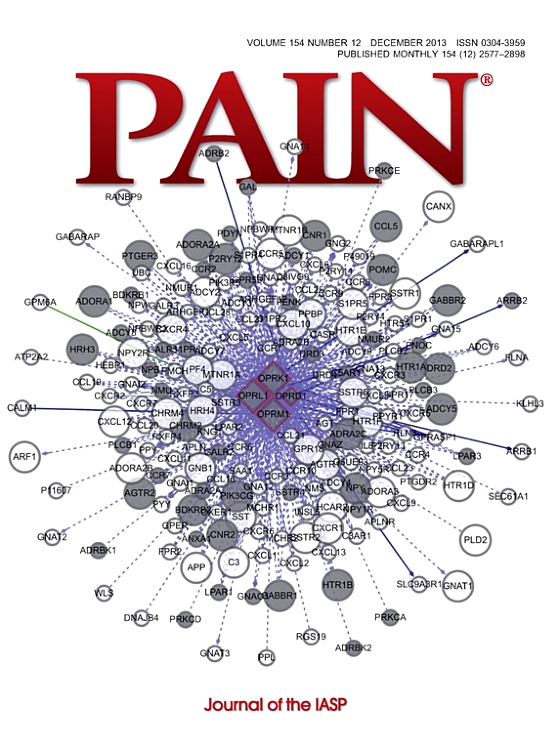Sensory neuron PIEZO1 deletion inhibits dynamic light touch sensitivity in uninjured mice, prevents neuropathic light touch hypersensitivity, and drives compensatory changes in dorsal root ganglia.
IF 5.5
1区 医学
Q1 ANESTHESIOLOGY
引用次数: 0
Abstract
Mechanotransduction is vital for sensing various mechanical stimuli, including blunt force and dynamic light touch. The sensation of a punctate mechanical force is very different from that of a brush swept across the skin, yet both involve mechanical stimulation of the skin and embedded sensory afferent endings. However, the sensory neuron mechanisms contributing to punctate vs light touch somatosensation, and how they might become dysregulated in nerve injury to cause pain, remain unclear. Here, we use mice with sensory neuron-specific PIEZO1 deletion to demonstrate sensory neuron PIEZO1 is required for dynamic light mechanical touch, and possibly punctate mechanical force, in healthy animals. These mice are also protected from acute and chronic tibial spared nerve injury-induced dynamic light touch hypersensitivity. However, dorsal root ganglia neurons from uninjured mice with sensory neuron PIEZO1 deletion displayed evidence of developmental compensation, including sensitized mechanically evoked inward currents. Dorsal root ganglia from these mice also exhibit transcriptional and functional compensation of other ion channels, including PIEZO2, TRPV1, and TRPV4. Thus, the behavioral phenotype of mice with sensory neuron-specific PIEZO1 knockout likely reflects these and possibly other forms of genetic compensation resulting from PIEZO1 absence throughout development, in addition to functional sensory neuron PIEZO1 deletion. Research using this transgenic mouse model must account for these caveats to facilitate accurate data interpretation. Furthermore, this article serves as a call for researchers to critically investigate possible genetic compensation in their mice. Such scrutiny is crucial to prevent replication crises and for advancement of scientific knowledge more broadly.感觉神经元PIEZO1缺失抑制未损伤小鼠动态光触敏感性,防止神经性光触超敏反应,驱动背根神经节代偿性改变。
机械转导对于感知各种机械刺激至关重要,包括钝力和动态轻触。点状机械力的感觉与刷在皮肤上的感觉非常不同,但两者都涉及皮肤的机械刺激和嵌入的感觉传入末梢。然而,感觉神经元机制对点状和轻触体感的影响,以及它们如何在神经损伤中变得失调而引起疼痛,仍不清楚。在这里,我们使用感觉神经元特异性PIEZO1缺失的小鼠来证明,在健康动物中,感觉神经元PIEZO1是动态光机械触摸和可能的点状机械力所必需的。这些小鼠也可以避免急性和慢性胫骨备用神经损伤引起的动态光触超敏反应。然而,来自感觉神经元PIEZO1缺失的未损伤小鼠的背根神经节神经元显示出发育补偿的证据,包括致敏的机械诱发内向电流。这些小鼠的背根神经节也表现出其他离子通道的转录和功能补偿,包括PIEZO2, TRPV1和TRPV4。因此,除功能性感觉神经元PIEZO1缺失外,感觉神经元特异性PIEZO1敲除小鼠的行为表型可能反映了这些和其他形式的遗传补偿,这些补偿是由整个发育过程中PIEZO1缺失引起的。使用这种转基因小鼠模型的研究必须考虑到这些注意事项,以促进准确的数据解释。此外,这篇文章还呼吁研究人员在他们的小鼠中批判性地研究可能的遗传补偿。这种审查对于防止复制危机和更广泛地推进科学知识至关重要。
本文章由计算机程序翻译,如有差异,请以英文原文为准。
求助全文
约1分钟内获得全文
求助全文
来源期刊

PAIN®
医学-临床神经学
CiteScore
12.50
自引率
8.10%
发文量
242
审稿时长
9 months
期刊介绍:
PAIN® is the official publication of the International Association for the Study of Pain and publishes original research on the nature,mechanisms and treatment of pain.PAIN® provides a forum for the dissemination of research in the basic and clinical sciences of multidisciplinary interest.
 求助内容:
求助内容: 应助结果提醒方式:
应助结果提醒方式:


